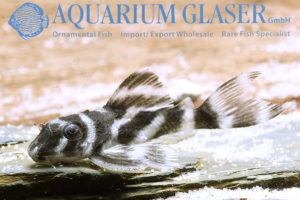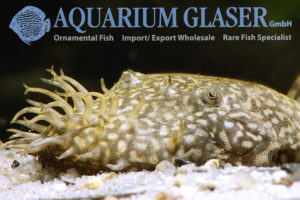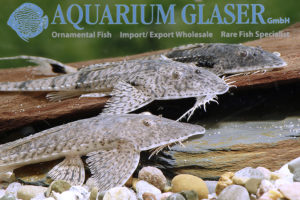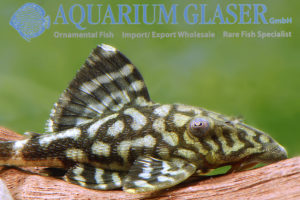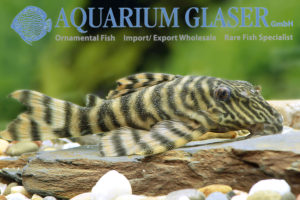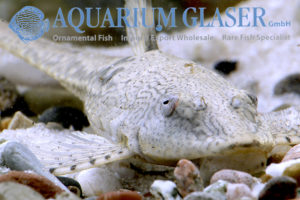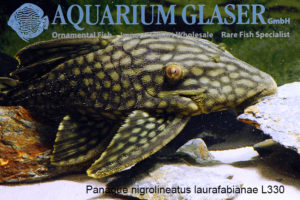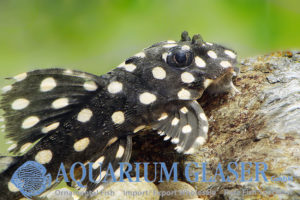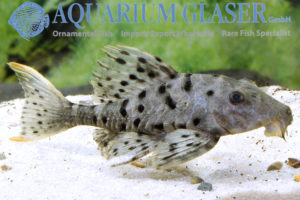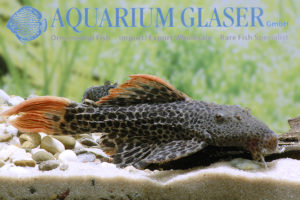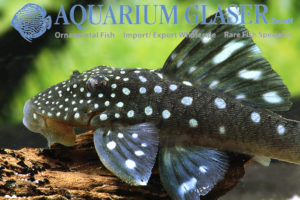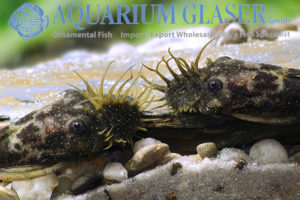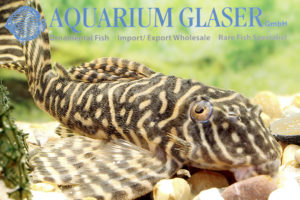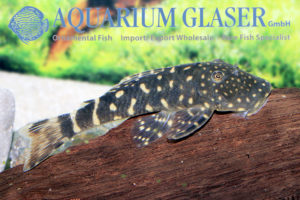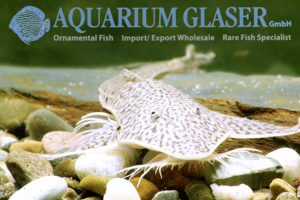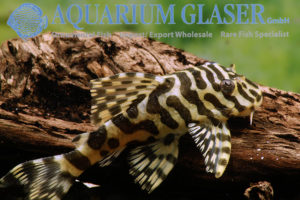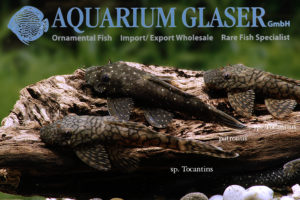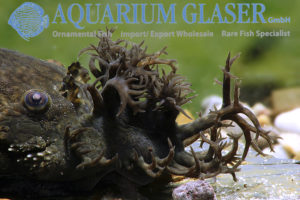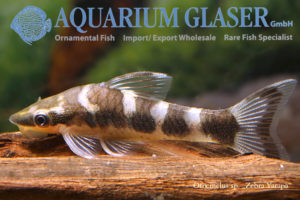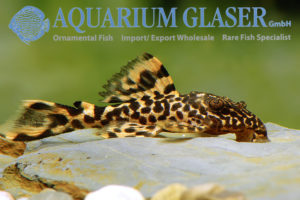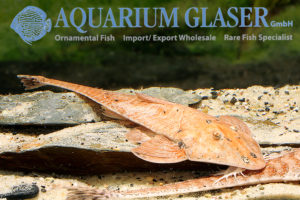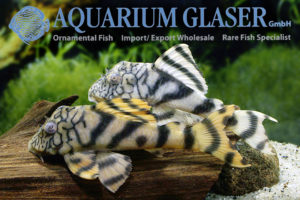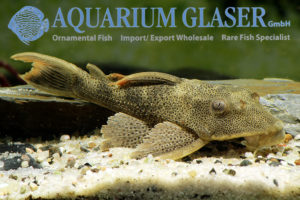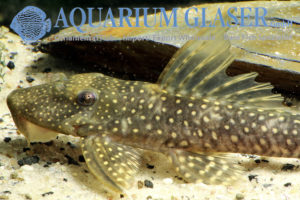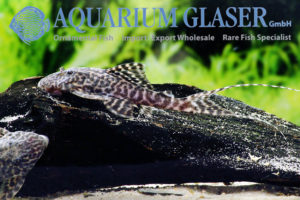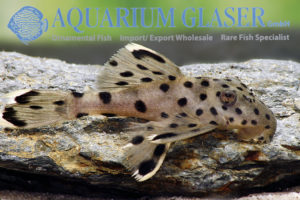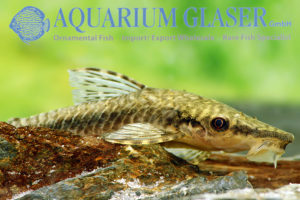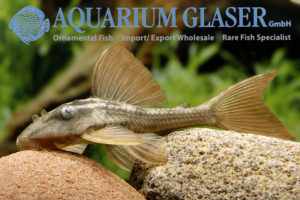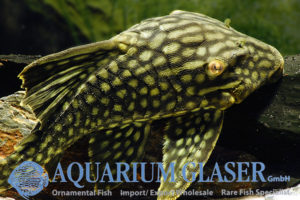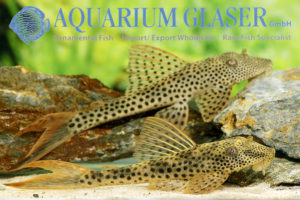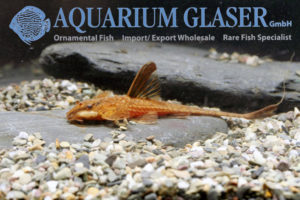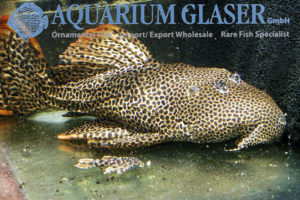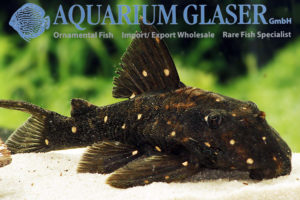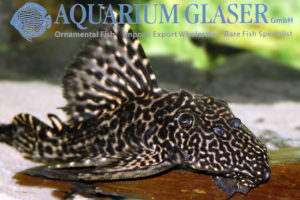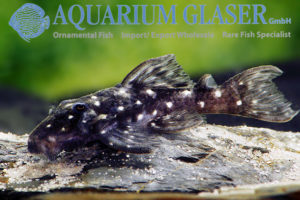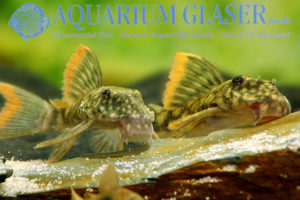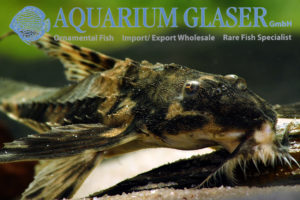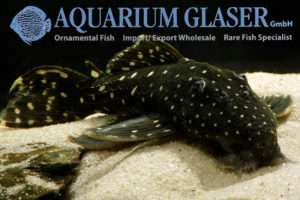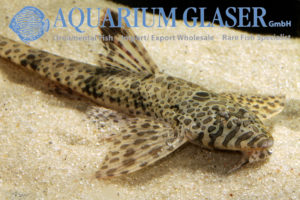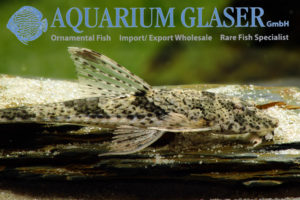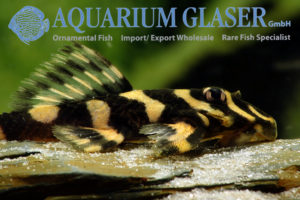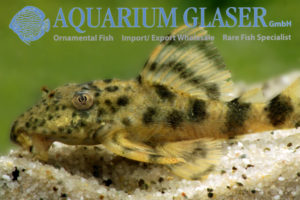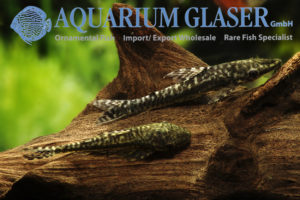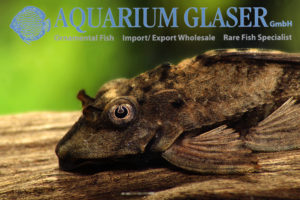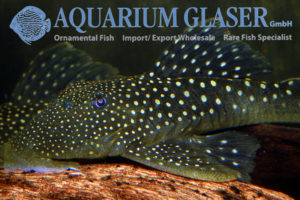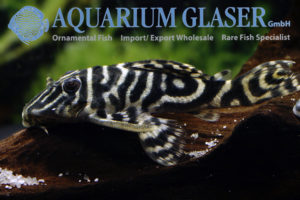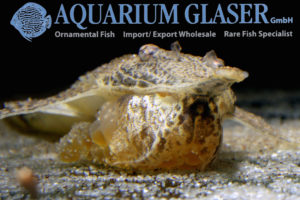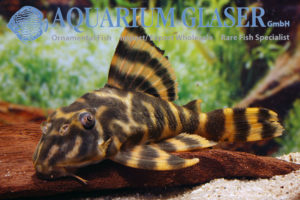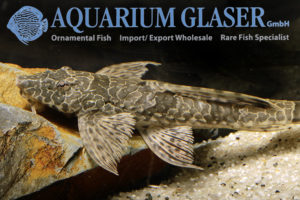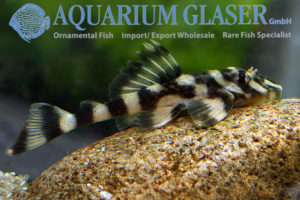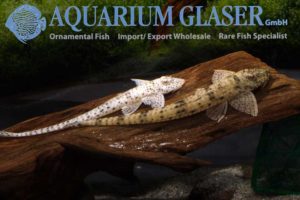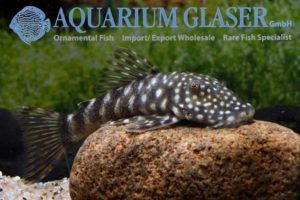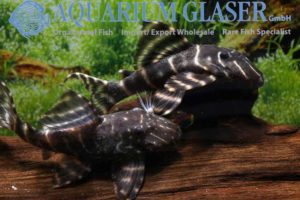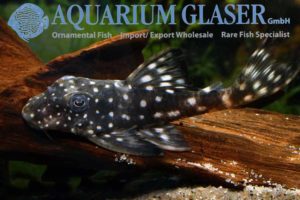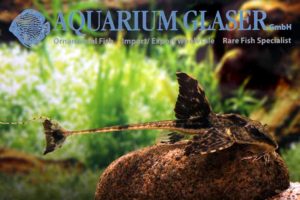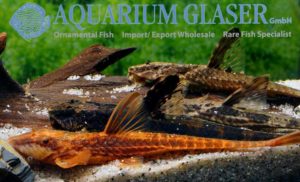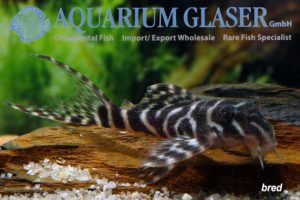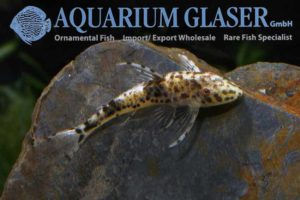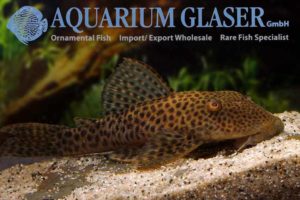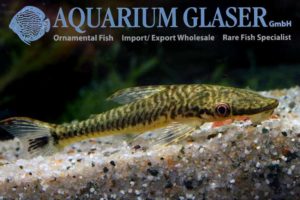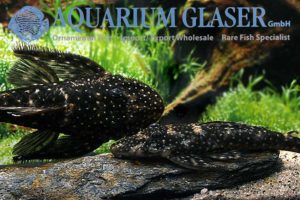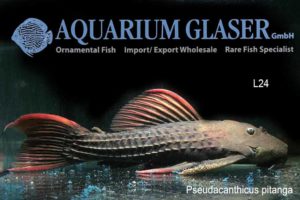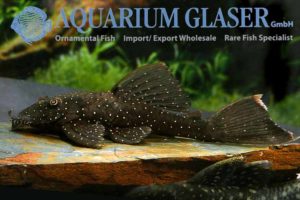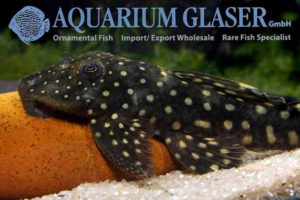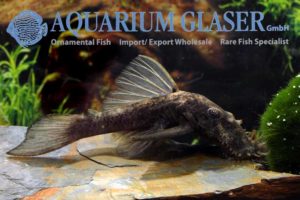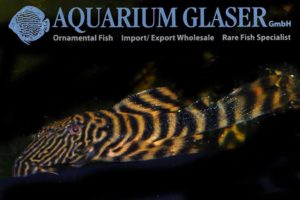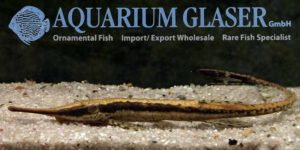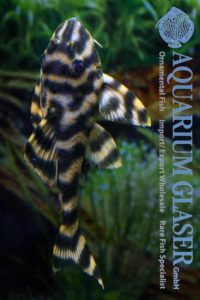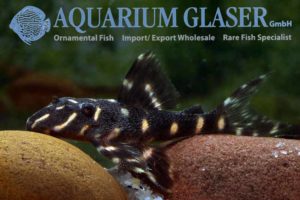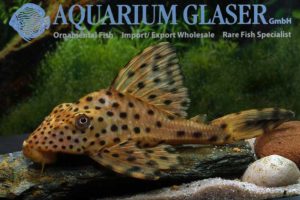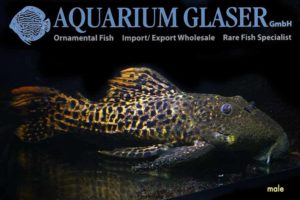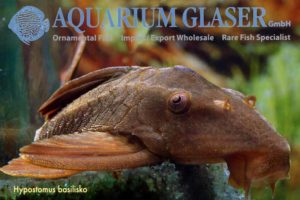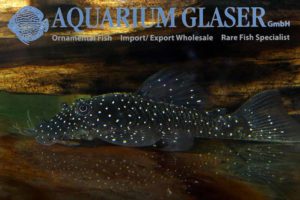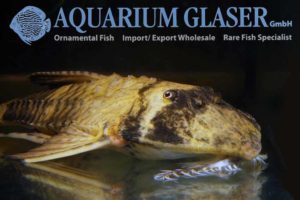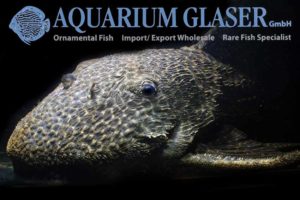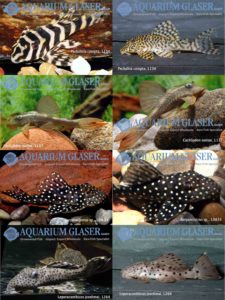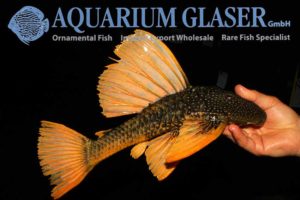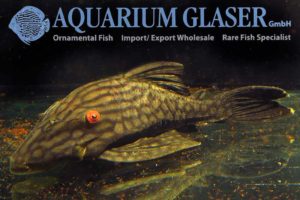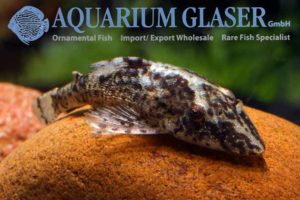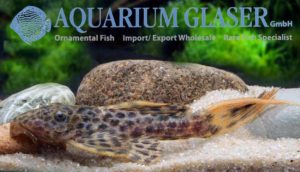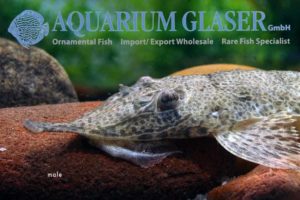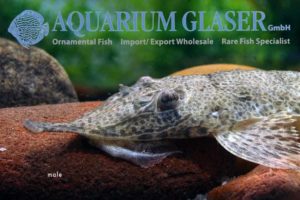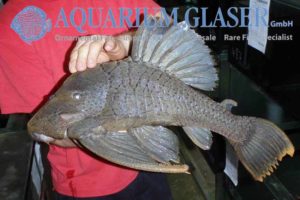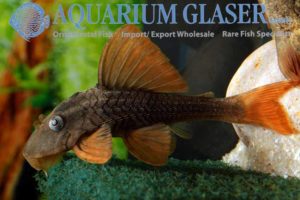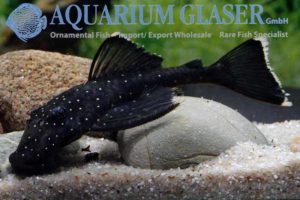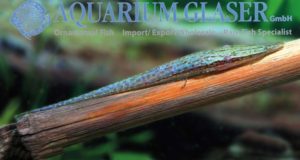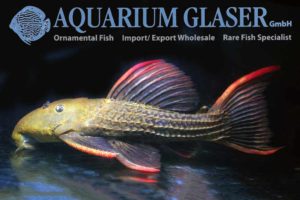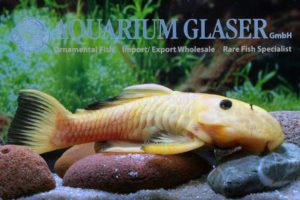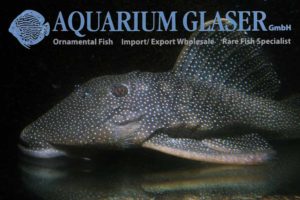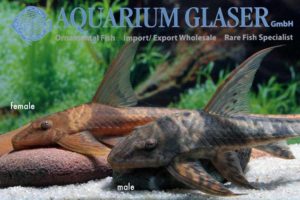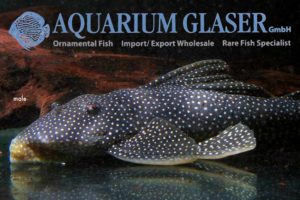In northern tributaries of the Amazon, namely the Rio Nhamunda (L475), the Rio Padauari (L499) and the Rio Uatumá (L500), there are very similar Hypancistrus, which have a relatively stocky body in common. In colour they resemble very much the Hypancistrus furunculus (L199) from the upper Orinoco. All four Hypancistrus are extremely variable in colour, […]
10b. Catfishes: Suckermouths, Plecos and L-numbers (318)
-
-
Ancistrus claro
One of the smallest Ancistrus species is Ancistrus claro, which was known as LDA 8 before its scientific description. The catfish originates from clear water streams with a strong current in the upper part of the Rio Paraguay-Paraná river basin and becomes at most 6-8 cm long. The sexes are not quite as easy to […]
-
Pseudohemiodon laticeps
Pseudohemiodon laticeps from Paraguay belongs to the longest known mouth-breeding Whiptail Catfish in the hobby, even if this large (up to 35 cm) species with its species-specific broad, triangular head was confused for a long time with the very similar, narrow-headed species P. platycephalus from Brazil. Mostly one sees both species in a fawn-brown colouring […]
-
Panaque schaeferi L203 L90c
Among the largest loricariid catfish are some of the wood-eating Panaque species. Panaque schaeferi is one of them, the species will certainly grow to about 60 cm long. Since P. schaeferi was described on the basis of adult specimens, the assignment to the young animals belonging to it has never been scientifically confirmed. However, it […]
-
Panaqolus sp. L2
The tiger pleco was already imported and presented in 1988; since then, unfortunately, no scientist has yet taken a closer look on the beautiful animals imported from Rio Tocantins in Brazil for the hobby; therefore, this relatively small, maximum 12 cm long, peaceful loricariid catfish still has no “correct” name, but has to be content […]
-
Sturisomatichthys leightoni
Until recently, two genera of closely related whiptail catfish were distinguished according to anatomical features: the relatively short-nosed Sturisomatichthys with four described species and the relatively long-nosed Sturisoma with over 15 species. All species are popular aquarium fish because they are attractive and easy to breed. Unlike most other loricariid catfish they do not breed […]
-
L330 scientifically described: Panaque nigrolineatus laurafabianae
Many fish scientists (ichthyologists) currently reject the concept of the subspecies. They argue that either there are definable characteristics, in which case it is a species, or there are no characteristics, in which case the form cannot be named. However, this concept has only limited relevance to reality; in the case of the large striped […]
-
Hypancistrus sp L471 “dwarf, big spots”
From the Rio Ventuari in Venezuela we have received this extraordinarily beautiful Hypancistrus, which is very similar to H. inspector, H. contradens and L201, but has considerably larger spots, which also appear slightly yellowish. At least wild collected L471 seem to remain much smaller than the other mentioned Hypancistrus and hardly grow beyond 6 cm. […]
-
Pseudorinelepis sp. L95
The loricariids of the genus Pseudorinelepis are the most heavily armored loricariids at all. They are widely distributed in the basins of the large South American rivers Amazon and Orinoco. The imported animals often look a little bit different, but scientifically only one species, P. genibarbis, is recognized at present. The coloration varies greatly individually, […]
-
Pseudacanthicus leopardus LDA7
Species of Pseudacanthicus are also known under their popular name “cactus catfish”, for the species are very spiny and it is no good idea to catch a larger specimen with bare hands. Some species of Pseudacanthicus can reach one metre in length, but there are other species that grow up only to 25 cm. As […]
-
L128 Blue Phantom
There is no „official“ paper that states in which genus this popular species from Venezuela should be placed in, but the catfish community agrees that it most probably is a member of the genus Hemiancistrus. Currently we have very nice youngsters of 3-4 cm length in stock, and some smaller as well as some larger […]
-
Ancistrus leucostictus
From the Guyana states (French Guiana, Guyana and Surinam) there are for various reasons hardly any commercial ornamental fish exports. The ornamental fish originating there, e.g. the glow-light tetra, are therefore practically exclusively traded as bred specimens. This is also true for Ancistrus leucostictus, which was brought back from a tributary of the Mazaruni River […]
-
Hypancistrus spec. L 401
This in the DATZ 12/05 newly introduced very beautiful Hypancistrus variant is currently available in small quantities. The animals remind in their habitus of L 333 and are sometimes confused with them. All in all L401 are more dainty, somewhat more stretched and reach only a total-length of maximum 12 cm, while L 333 can […]
-
Chaetostoma sp. L455 Tiger
After longer time we could import again the beautiful Chaetostoma sp. L455 Tiger from Peru. Generally speaking, Chaetostoma species do not stand out because of their attractive colors, but this species makes a clear exception – at least the males. The females are colored considerably simpler. Some specimens show a red coloration in the tail […]
-
Pseudohemiodon sp. Peru II German Bred
Floundercatfish are very popular with catfish lovers because they combine an interesting appearance with the interesting mouth brood care. Some species become quite big, so P. laticeps from Paraguay, that can become well and gladly 35 cm long, but there are also smaller species. Among the latter are two scientifically seemingly not yet described species […]
-
L134 Peckoltia compta
The L-number catfishes are like us humans. There are pretty, very pretty and extraordinarily pretty specimens. To the latter group belong the L134 (Peckoltia compta) from the Rio Tapajós, which we currently have in stock. P. compta belongs to the most recommendable L-catfishes at all and unites all desired characteristics of this group in ideal […]
-
Ancistrus patronus and Ancistrus sp. “Rio Tocantins”
In small numbers we received German bred specimens of these pretty bristle-noses. Ancistrus patronus is one of the numerous white dotted, black species and was known in the hobby as Ancistrus sp. “Puerto Ayacucho” and A. sp. “Rio Parucito” before its scientific description in February 2019; the numbers L125 and L150 were given to imported […]
-
Ancistrus sp. Paraguay
After Paraguay had closed its doors for half a year for the export of ornamental fish, now imports from the southern country in South America reach us again. Among them also various Ancistrus species, which are often sent mixed. It has become common practice in the trade to call these animals Ancistrus tamboensis, which is […]
-
Zebra Otocinclus
Currently we have two forms of very attractive Zebra-Otocinclus from Peru in stock. The first species, Otocinclus cocama, is more commonly available. It shows a rather dense pattern of vertical black stripes on a light background and has the code number 274154 (see also http://www.aquariumglaser.de/de/otocinclus-cocama_de_1342.html_de_1342.html). Only in small quantities and very rarely we get a […]
-
Leporacanthicus triactis VARIETIES
Currently we received an import from Venezuela, which included small, only 3-4 cm long specimens of Leporacanthicus triactis, also known as L91. Among them are an unusually large number (approx. 10) of unusually beautifully drawn variants. Normally small L91 do not look much different than the adults, only a little lighter in basic tone. But […]
-
Sensational: Red Pseudohemiodon apithanos!
Recently we received red chameleon whiptails (Pseudohemiodon apithanos) from Colombia. The coloration of the eight specimens (a ninth was a “normal” apithanos, which we also received) is really fantastic. Red variants can be found in different loricariid catfish, think of Hemiloricaria and Ancistrus, but for the genus Pseudohemiodon they are not known yet. The individual […]
-
Peckoltia sp. L135
Currently is season for one of the most beautiful members of the genus Peckoltia, namely L135. The species originates from the Rio Negro and can be easily recognized by the “wormline-pattern” on the head. Only two other species of Peckoltia show a similar pattern: P. braueri from the Takutu river and P. sp. L121 from […]
-
Hypostomus rhantos L242
With almost 150 accepted species, the genus Hypostomus (in the broadest sense) is the most species-rich group of loricariid catfish. Unfortunately, there is no current revision of all species and so the determination of Hypostomus is usually a laborious affair, in the end often only a questionable result. Hypostomus rhantos is pleasingly easy to recognize. […]
-
Pseudancistrus sidereus
Nasty people could say: another brightly spotted brown-black loricariid catfish. But the heart of real fans of this group of animals beats faster at the sight of the fish, which differs from all other L-catfish by the combination of the crescent-shaped dorsal fin and the tail fin coloration, which is actually typical for Lasiancistrus species. […]
-
Panaqolus sp. L351
From Peru comes a Panaqolus, that is charcterized particularly through the small eye and the long tail fin filaments. With L351 they got their own code number. Unfortunately L351 is imported only very rarely, because most photos of this species show a darkly colored, unattractive fish. In reality, the animal is very nicely colored after […]
-
L264 Leporacanthicus joselimai German bred
Leporacanthicus joselimai (L264) comes from the Rio Tapajós in Brazil and grows 15-20 cm long. It belongs to the carnivorous species of suckermouth catfish and should therefore be fed with a wide range of feed, such as frozen food, granules, flakes, etc.. Since most of the food is eaten at night, it is necessary to […]
-
Hypoptopoma gulare
The genus Hypoptopoma comprises small to medium sized loricariids. The largest species known becomes about 10 cm long. At the first glimpse they look much alike a Otocinclus, but larger. Typical for members of Hypoptopoma is the position of the eyes. They are placed in way at the side of the head that the fish […]
-
L137 Hypostomus soniae / Cochliodon soniae
The pretty, blue-eyed L137 from the Rio Tapajós is only rarely offered. It is a medium-sized species of Hypostomus that can reach a maximum length of about 20 cm. The colour of the fish is quite variable. Specimens exist that have rather brown fins, others have spotted fins and again others have bright orange-red fins. […]
-
Panaque sp L330
The „Full Spotted Royal Pleco“ belongs to the very attractive members of the wood-feeding genus Panaque. The species attains a maximum size of about 40 cm. Sadly in young fish the adult coloration cannot become even guessed, they are striped, like many other members of the genus. Only in halfgrown fish the spotted pattern has […]
-
Squaliforma cf. emarginata L11
Among the loricariid catfishes that are known by scientists for a very long time already is this species. It has been described initially 1840 under the name of Hypostomus emarginatus. Since then it has been placed in different genera, in 2001 in Squaliforma and in 2016 in Aphanotorulus, when Squaliforma has been considered to be […]
-
Hemiloricaria lanceolata Red
It was back in the 1980ies that a brick-red sport of whiptail catfish appeared in the former GDR. The real origin of the fish stays a mystery, but it was possible to cross it with Hemiloricaria (formerly Rineloricaria) lanceolata. The strains that exist nowadays are most probably all hybrids. The initial red whiptail catfish belonged […]
-
Pseudacanthicus cf. leopardus: L 114 big and small
The L-catfish L 114 is a close relative of Pseudacanthicus leopardus (please see our entrance on LDA 7 for that); currently we have different sizes of the beautiful L 114 in stock, among them (very rarely offered) 25-30 cm long specimens which are almost fully grown and in any case mature and one of the […]
-
Panaqolus albomaculatus LDA 31 Venezuela
In one of the most current issue of the Datz magazine (Datz 3/2018) a new L-number has been published, namely L501. This is a Hypancistrus from Venezuela belonging in the closer relationship of Hypancistrus inspector/L201/L339. It differs from the so far known relatives by the almost unspotted fins and the rather pinkish/orange spots (instead of […]
-
Leporacanthicus triactis L91 Variety
The tooth-nose Leporacanthicus triactis from Venezuela s a beautiful aquarium fish that has a number of advantages. Besides the very nice coloration it does not become too big (maximum size reported is about 30 cm, but most specimens in the wild stay much smaller) and it is an omnivorous fish that readily accepts all types […]
-
Micracanthicus vandragti L280
One could think that this unusual suckermouth catfish – it originates from the Rio Ventuari in Venezuela – represents the juvenile form of a Leporacanthicus, for example L240 or L241. But in fact L280 is a dwarf species that hardly ever becomes bigger than 5 cm. Until now only single specimens appeared in the trade, […]
-
Guyanancistrus guahiborum L106
Currently we have extremely nice youngsters of L106 in stock. They originate from Venezuela. There is a second, very similar L-number, L122. L106 has a deeper body. Maximum size reported for L106 is about 15 cm, recently our fish are 4-6 cm long. The species has been described scientifically in 2005 under the name of […]
-
Brochiloricaria macrodon
We received from Paraguay this wonderful mouthbrooding whiptail catfish. Once we had this species even as bred ones in stock – many years ago. In our recent import the prolongations of the fins are very obvious. This reminds a bit in Lamontichthys. However, Brochiloricaria has a completely different mouth structure and feeding habit. Brochiloricaria are […]
-
Leporacanthicus sp. L326
This unusual Leporacanthicus originates from the Orinoco. The L-number was given already back in 2002. Initially the fish was imported from Colombia. It is said that these fish were collected in the area around Puerto Carreño. We currently received this fish for the first time ever; our specimens come from Venezuela. L326 differs from all […]
-
Hemiloricaria melini
Lately we introduced to you Hemiloricaria sp. „Puerto Ayacucho“, a species known so far from Venezuela only, which we could import along with Hemiloricaria melini from Brazil. This post led to a number of requests wether we could also depict the imported melini-Whiptails. Well, we can: here they are! Hemiloricaria melini forms along with H. […]
-
Hemiloricaria sp. „Puerto Ayacucho“
Finally we were able again to import some of the beautiful Hemiloricaria melini from ´Brazil (Rio Negro basin). As usual this shipment contained several bycatches, like H. sp. Weißdorn and H. castroi (see our post http://www.aquariumglaser.de/en/fish-archives/hemiloricaria-bycatches/), but this time there were also some specimens we have never seen before. The most obvious feature of the […]
-
L168 Zonancistrus brachyurus
We obtained wonderful L168 from Brazil. In this case the L-number provides a safer information than the scientific name. Due to several misidentifications this fish was in the hobby initially named Peckoltia pulcher, then Dekeyseria pulcher, sometimes also Zonancistrus pictus. But the valid name (this is at least current state of the art) is Zonancistrus […]
-
Peckoltia brevis / LDA 78
We received this beautiful small pleco once more from Brazil. The species became popular in the hobby long time before any L-numbers were created. Peckoltia brevis attains a maximum length of about 12 cm. It originates from affluents of the Amzaon river, for example from the Rio Purus, the Rio Jurua, the Rio Manacapuru, and […]
-
Hypoptopoma psilogaster
The genus Hypoptopoma comprises small to medium sized loricariids. The largest species known becomes about 10 cm long. At the first glimpse they look much alike a Otocinclus, but larger. Typical for members of Hypoptopoma is the position of the eyes. They are placed in way at the side of the head that the fish […]
-
Glyptoperichthys scrophus
The genus Glypterperichthys (Sailfin plecos) is represented in the hobby mainly by thetwo species G. gibbiceps and G. joselimaianus, because both species have a very attractive coloration. Both are bred in large numbers in Southeast Asia and so they are almost anytime available for moderate prices. A rarity is G. scrophus, the rhino sailfin pleco […]
-
L 128 Hemiancistrus sp. or Ancistrinae gen. sp.
Many L-numbers have received correct scientific names in the meantime; not so the „Blue Phantom“, which ist stil undescribed. Currently most keepers tend to place the species in the genus Hemiancistrus, but this is not confirmed. It is also possible that the fish will have to be placed in a new genus (Ancistrinae gen.sp.). We […]
-
Extraordinary attractive Hypancistrus debilittera (L129) arrived!
Currently is the best import season for plecos from the Rio Orinoco. So we have a large number of species in stock. Among them is of course Hypancistrus debilittera, which was called L129 before it became described scientifically. This is a pretty, small species with an enormous range of colour pattern. There hardly exist two […]
-
Hemiodontichthys acipenserinus
This species has been named “Pinocchio cat” in the trade due to its funny looking nose. The species represents the smallest of all mouthbrooding whiptail cats – it usually grows only to 10 cm total length in aquaria – and is thus very well suited for keeping. We currently were able to import these beautiful […]
-
Peckoltia sp. Red Tiger L209
When we imported this beauty for the very first time it was not possible to identify it as a already known species. But now there is a consensus among hobbyists that it is identical with L209. L209 is a typical member of the genus Peckoltia. The omnivorous species attains a maximum length of about 15 […]
-
Hemiloricaria teffeana
The vicinity of Tefé (written Teffe in elder publications) in Brazil is a place of wonders in aquarists eyes. When the name Tefé is spoken everybody is reminded in beautiful Green Discus and gorgeous Apistogramma agassizii from that region. But ther also lives a very attractive whiptail catfish: Hemiloricaria teffeana. However, the species has a […]
-
Zonancistrus sp. L52
The season for plecos from the rio Orinoko started very well. Many much sought for species are available in many different sizes. Most specimens of the Orinoco Butterfly Pleco (L52) we currently have in stock are charming and very pretty youngsters, but we also have a few large (9-11 cm) animals in our fishhouse. The […]
-
Pseudoloricaria sp.
Yesterday we introduced to you a brandnew „Hemiloricaria“ and mentioned that the determination of the species is very doubtful. Now we were able to take pictures of the ventral side of the animals and the enigma was solved: these fish are no Hemiloricaria at all, but members of the genus Pseudoloricaria! In Pseudoloricaria the lower […]
-
Chaetostoma L455 Tiger
After quite a long time we were able again to import the pretty Chaetostoma sp. L455 Tiger from Peru. Generally speaking, species belonging to Chaetostoma do not attract by nice coloration, but this species is really an exception from the rule. This is true at least for the males, the females do not have the […]
-
Panaqolus albivermis, L204
Currently we have all sizes of L204 in stock, among them fully grown specimens. They show impressively how different the individual pattern in loricariids can be. We have specimens with small spots, species-specificly banded animals and all thinkable intergrades. The photos were made from four fully grown specimens in our fishhouse, size-class 11-14 cm. Pictures […]
-
L102, Hypancistrus inspector
Once more we could import the beautiful Snowball Pleco (Hypancistrus inspector, L102) from the Rio Negro in Brazil. The species can attain a maximum length of about 18-20 cm and is one of the largest species in Hypancistrus. However, our fish in stock are currently only 6-12 cm long. In the most current import we […]
-
Loricaria sp. Rio Atabapo
Finally we are able again to offer bred specimens of this Loricaria. It is the most beautiful species of the genus. Like all its relatives it is a mouthbrooding species. The males carry the egg-clusters along with them. For this they use the lower lip, which becomes much bigger during the breeding season, until the […]
-
Rineloricaria lanceolata
Currently we obtain very nice Rineloricaria lanceolata from Paraguay. This species of whiptail catfish is very variable in respect of coloration. Almost all colours from deep dark brown (almost black) to a light clay-brown can be observed. It was back in the 1980ies that a brick-red sport of whiptail catfish appeared in the former GDR. […]
-
Hypancistrus sp. L66 King Tiger Pleco
The King Tiger Pleco originates from the Rio Xingu in Brazil. The species belongs to the most popular plecos in the hobby. This fish attains a length of about 15 cm. Currently we can offer very nice German bred ones (4-5 cm long), which have a pretty and strongly contrasting black-and-white-pattern. Like in all species […]
-
Parotocinclus cf. variola
For the first time ever we were able to import this interesting dwarf suckermouth catfish. It originates from a only recently discovered region, namely the waterfalls of Cachoeira do el Dorado in the far northern parts of Brazil, almost at the border to Venezuela. This area has not been explored ichthyologically yet. Of all the […]
-
Hypostomus sp. LDA10
The great rush for l-numbers is over, no doubt. But even at the highest level of the hype some of the species appeared only once or twice in the ornamental fish market. One of those guys is LDA, a species of Hypostomus with an extraordinary broad head. Obviously this species lives syntopically with the much […]
-
Hypoptopoma cf. psilogaster “sp. II”
The dwarf catfish of the genus Hypoptopoma are close relatives of the much better known Otocinclus species. Both genera have a similar habit and a similar way of life. Members of Hypoptopoma have a very typical position of the eyes. This gives them the advantage to be able to see what happens below them them […]
-
Flyer-cats from Brazil!
Recently we received a shipment of flyer-cats (Pseudolithoxus), which have been collected in the surroundings of Sao Gabriel do Cacheiro at the Rio Negro. At the first glimpse the fish look very similar to P. anthrax (L235) from Venezuela. But they are distinguished from the latter by the much larger white spots and the white […]
-
L24 has been described: Pseudacanthicus pitanga
Another L-number has received a correct scientific description finally: L24. The beautiful orange finned cactus pleco from the Rio Tocantins is named now Pseudacanthicus pitanga. The specific name “pitanga” is from the Tupi-Guarini language and means “red” in allusion to the colour of the fins. The scientific paper also discusses the risks of using this […]
-
Glyptoperichthys joselimaianus: L1
L-numbers are for many people simply synonyms for Loricariids. But one should remember that they have been cooked up only in 1988! L-numbers were given for species that have not been determined scientifically yet. The very first L-number, L1 (or L001, although nobody would have dreamed of hundreds of L-numbers initially) has been applied on […]
-
Ancistrus sp. L181 Rio Negro
The many species of Ancistrus with small white dots are very difficult to tell apart. We recently obtained L181 from the Rio Negro in Brazil. The very same species has been given several L-numbers, eg L71 (from the Rio Tapajós) or L249 (from the Rio Trombetas and its affluent, the Rio Cuminá). Also extremely similar […]
-
Pseudancistrus sp. LDA 32/L259/L321 Rio Tapajós
Currently four syntopically occuring forms of Pseudancistrus are reported from the Rio Tapajós. They differ from each other by minor differences in respect of coloration and proportions. L321 is the comparatively flattest of them, has small dots and a reddish seam at the caudal fin. LDA32 and L259 are a bit deeper bodied and have […]
-
Ancistrus sp. Black Rio Negro (L88)
We received a good number of pure black Ancistrus from the Rio Negro. These have no clearly visible markings, except one: a deepblack spot on the basis of the dorsal fin. This somewhat unspectacular, but characteristic feature made finally the determation possible. Our fish belong to the species named “L88” or Anstrus sp. Black (the […]
-
Panaqolus sp. Alto Nhamunda
Along with the spectacular Peckoltia sp. “Alto Nhamunda” (see http://www.aquariumglaser.de/en/news.php#1245) a specimen of Panaqolus reached us, which is very similar to the L-number L374. Very similar is also L403. Both L-numbers most probably represent the same species. One should not forget that a L-number is not given for new species, but for Loricariids exported from […]
-
Farlowella vittata
The needle suckers of the genus Farlowella are quite specious. To date 27 species are recognized as valid. As many species look very similar to each other the exact determination often proofs to be quite difficult. The 27th species has been described very recently from Colombia (it is the species Farlowella yarigui which has not […]
-
Peckoltia sp. Alto Nhamunda
We are glad to be able to present to you another jewel by the end of the week again. We could import last year already a new species of Peckoltia from the upper Nhamunda River in Brazil, which is also famous for its pretty discus. This first importation contained only fully grown specimens (see http://www.aquariumglaser.de/en/news/Peckoltia_sp_Alto_Nhamunda_en/). […]
-
L204 Panaqolus albivermis
One of the most beautiful L-numbers at all has obtained an official, valid name in 2013: Panaqolus albivermis. The species originates from Peru. We currently were able to import again a good number of wonderful young specimens of this small species of catfish (maximum length around 10 cm). Among them are also 5 spotted individuals. […]
-
L167 arrived!
Finally we were able to import again one of the most attractive species of Cochliodon: L167. The species belongs to the typical representatives of the genus, which feed mainly on soft wood. This can be recognized by the very few teeth, which have a specialized shape with a broad, mussel-shaped cusp. L167 originates from the […]
-
L273 Pseudacanthicus sp. Titanic XL
The Titanic was never traded in large numbers and is one of L-numbers in great demand. We received now three large specimens from Brazil, which seem to be fully grown. They are 25-30 cm long. One of them is for sure a male. It can be easily identified by the strong spines and the long […]
-
Cochliodon sp.
Among the most popular fishes from Paraguay is the Violet Red Bruno. Finally the species has attained a scientific name: Hypostomus basilisko. The distribution of the fish is the Rio Paraguay, both in Brazil and Paraguay. Here it occurs along with two quite similar species of the Cochliodon-group of Hypostomus, namely Hypostomus cochliodon and Hypostomus […]
-
L107 / L184 Brillant-Ancistrus
Among the most beautiful species of Ancistrus is this one. It originates from the middle Rio Negro area in Brazil and is not yet determined scientifically. Instead even two L-numbers have been given to it, namely L107 and L184. The Brilliant Ancistrus is a very peaceful species. The number and size of the white spots […]
-
Paraloricaria vetula
The genus Paraloricaria contains three species that are distributed in southern South America. The fish are virtually unknown in the hobby. This is for sure at least in part due to the enormous size the fish can reach. At least P. commersonoides and P. vetula become larger than 50 cm. For the first time ever […]
-
L234 Megalancistrus sp. Rio Urguayo
We were able to import two pretty gobbets from Paraguay, or, to be more detailed, from the Rio Urguayo. The two Megalancistrus are currently 40-50 cm long and show clearly why they have deserved their generic name: Megalancistrus means “gigantic Ancistrus”. Scientifically speaking, our fish most probably belong to the species M. parananus. For our […]
-
L-numbers: the season starts for species from the Rio Tapajós!
-
Hypostomus luteus
Yesterday the most beautiful of all plecos, Hypostomus luteus from Paraguay, arrived. Only fully grown specimens display the fantastic, reddish-yellow coloration, whereas young fish are black with light spots. All specimens are 35-40 cm long. For our customers: the animals have code 262639 and 262649 on our stocklist. Please note that we exclusively supply the […]
-
L330 Panaque sp. Spotted 14-18 cm
We have some specimens of this gorgeous, wood-eating pleco in stock. L330 originates from Colombia. Fully grown specimens get a spotted pattern all over the body. Younger specimens can look quite similar to L190 or Panaque nigrolineatus, because they usually show a striped pattern. The yellow tips of the caudal fin are a good hint […]
-
Parotocinclus longirostris
These dwarf sucker cats reaches us from Brazil. They belong to the smallest species of sucker cat at all. Even fully grown they hardly extent 2.5 cm in length. The determination on species level is not absolutely confirmed, for obviously a complex of very similar species exists. However, in any case the fish are tiny […]
-
L114 Pseudacanthicus sp., small
-
Hemiodontichthys acipenserinus
This species has been named “Pinocchio cat” in the trade due to its funny looking nose. The species represents the smallest of all mouthbrooding whiptail cats – it usually grows only to 10 cm total length in aquaria – and is thus very well suited for keeping. We currently were able to import these beautiful […]
-
Hemiodontichthys acipenserinus
These strange whiptail catfish, in nature living in a sandy habitat, are regularly imported, although in low numbers. This species requires a sandy substrate, in which they can hide themselves. Because this is a shy fish absolute care needs be taken in the choice of tank mates. The reproduction of this species is not very […]
-
We can “big”, too…L191
Ornamental fish are not necessarily small. Last week we received this juggernaut, a Panaque sp. “L191”. The animal has taken the transit from Colombia in our fishhouse in stride and has settled down perfectly.
-
L137 Hypostomus soniae / Cochliodon soniae
The pretty, blue-eyed L137 from the Rio Tapajós is only rarely offered. It is a medium-sized species of Hypostomus that can reach a maximum length of about 20 cm. The colour of the fish is quite variable. Specimens exist that have rather brown fins, others have spotted fins and again others have bright orange-red fins. […]
-
Pseudolithoxus nicoi
We could import some specimens of the pretty white seam flyer cat from Venezuela. This rarely offered species attains a maximum length of about 12 cm. For our customers: the fish have code 284633 on our stocklist. Please note that we exclusively supply the wholesale trade. Text & photos: Frank Schäfer
-
Acestridium dichromum arrived!
We received the very rare dwarf suckermouth catfish Acestridium dichromum from Venezuela. The species attains a length of 5-6 cm only. The species could be called “chameleon dwarf sucker cat”, for it becomes bright green when sitting on plant leaves, but changes colour to brown within a few days when only roots and stones are […]
-
A new Cactus Cat related to L24/L25
The Cactus Cats L24 and L25 become around 25-30 cm long and are quite popular among hobbyists with spacy tanks. The fish are very colorful and scientifically still undescribed. L24 originates from the Rio Tocantins and Rio Araguaia, L25 from the Rio Xingu. The two can be best distinguished by the pattern of the head: […]
-
L56x Parancistrus sp. 2-color
We have obtained a small number of this very unusual loricariid from Brazil. “Technically” speaking, they belong to the species P. aurantiacus. The species is famous for the fact that they can be bright golden, marbled or black colored and it is documented that they can change the colours in comparatively short time. This phenomenon […]
-
Baryancistrus xanthellus (L18) adult
The Yellow Seam Plecos or Golden Nuggets of the genus Baryancistrus (L18, L81, L177, see http://www.aquariumglaser.de/en/fish-archive/l-numbers-en/_en-2/ for an overview) belong to the most desirable species of pleco at all. Young fish look very beautiful. However, almost exclusively young specimens are available in the trade. Thus we were very glad that we were able to manage […]
-
Lamontichthys llanero
Currently we have this beautiful, but only very rarely available catfish in different sizes in stock. For more information on the species please see http://www.aquariumglaser.de/en/fish-archive/catfish-en/loricariidae-en/Lamontichthys_llanero_en/http://www.aquariumglaser.de/fischarchiv/welse/loricariidae/Lamontichthys_llanero_de/ For our customers: the fish have code 264854 (5-8 cm) and 264856 (10-12 cm) on our stocklist. Please note that we exclusively supply the wholesale trade. Text & photos: Frank […]
-
Scobinancistrus sp. L253
This beautiful loricariid originates from the Rio Xingu. It becomes collected upstream from Altamira. In all probability the species can attain a maximum length of about 35 cm, but there are no reliable information on that topic available. The pretty pair we have currently in stock (and which made a good job as photo model) […]
Hemiloricaria bycatches

The past days were dominated by whiptail catfish. Along with our first importation of Pseudoloricaria sp. (see http://www.aquariumglaser.de/aktuelles/pseudoloricaria-sp-2/) came as bycatch not less than four different species of Hemiloricaria! This is extremely unusual, for all these species have a very similar way of life and so they stand in direct competetion to each other. The four species are Hemiloricaria fallax, H. teffeana, H. castroi, and H. sp. Barcelos.













May this be as it is: we also obtained – from the very same area – even a fifth species, namely Hemilorcaria sp. Weißdorn, also known under the name H. sp. Amazonia. Raphael Covain, a French scientist that works a lot with Rineloricaria, informed us – based on his research on the genus – that the latter species is identical with Rineloricaria platyura.

The generic names Hemiloricaria and Rineloricaria have both been established in 1862 by P. Bleeker. The validity of Hemiloricaria is reason for a debate among scientists. There are two basic opinions, the one is that both genera are valid, the other (i.a. the one of Covain) that Hemiloricaria is a synonym od Rineloricaria.


We are not specialized in this group of fish and simply follow the opinion that is most commonly shared in the German speaking area. This is that Hemiloricaria is a valid genus. In any case we thank Raphael Covain sincerely for his help. Many thanks also to Ingo Seidel who helped us to identify the bycatches of Pseudoloricaria.
For our customers: we currently have the following species that were mentioned above in stock: H. sp. Weißdorn/H. platyura (code 288965), H. fallax (code 287804) and one specimen of H. cf. castroi (code 287655). Please note that we exclusively supply the wholesale trade.
Text & photos: Frank Schäfer
First import of Rhadinoloricaria macromystax

Even keepers specialized in whiptail catfish will hardly know this fish. Until now only preserved specimens or pictures of animals photographed in the field were known. Now we were able for the first time ever to import some specimens alive from Venezuela. The species has been described in 1869 from Peru.


These fish are extremely sensitive. Our supplier reports that he has big difficulties during the acclimatization of the fish. The reasons for these difficulties are unknown. The way the fish hold their pectoral and ventral fins (like spoilers) may be a hint that these whiptail cats are adopted to strong current (a so-called rheophilic species).

The species is said to attain a length of about 15 cm. This means that our specimens are fully grown or at least sexually mature. If they represent the “real” Rh. macromystax or a close, still undescribed relative, cannot be decided by us. The genus is only insufficient researched.

For our customers: the animals have code 287255 on our stocklist. Please note that we exclusively supply the wholesale trade. Only very few specimens available!
Text & photos: Frank Schäfer
Leporacanthicus from the Rio Tapajós: L263 and L264




We
received from Brazil two species of pretty carnivorous loricariids.
Both originate from the Rio Tapajós, where they occur even syntopically.
L264 has been described scientifically under the name of
Leporacanthicus joselimai, whereas L263 still waits for a scientist to
take a closer look on it.




It is very unusual that two closely related species live in the wild together. Usually one species will dominate the other. But in this case it obviously works. Both L-numbers for sure represent species on their own, as both have been bred already successfully in aquaria.
Both species attain a maximum length of about 15-20 cm.
For our customers: the fish have code 26480-L 263-3 (L263) und 26480-L 264-3 (L264) on our stocklist. Please note that we exclusively supply the wholesale trade.
Text & photos: Frank Schäfer
Panaque Blue-Eye

We
were able to import two large males of this top rarity. There is still
an ongoing debate among specialists whether Panaque suttonorum (= P.
suttoni) and P. cochliodon do represent the same species or not.
However, in the most recent scientific revision, P. suttonorum is
considered to be valid.

For
our customers: the animals have code 275007 on our stocklist. Please
note that we exclusively supply the wholesale trade. Only two specimens
available!
Text & photos: Frank Schäfer
Finally available again: L135!


The
L-catfish L135 belongs to the most attractive L-numbers. Most
specialists currently believe that it represents a variety of the
species Peckoltia braueri. This species has been given also two other
L-numbers, eg 121 and 305. L135 from the central Rio Negro basin is the
most colourful of them. This catfish attains a maximum length of 12-15
cm and has been bred in aquaria already. It is only very rarely
available as wild collected stock, so we are quite glad about our
successful importation!


For
our customers: the fish have code 26480-L 135-1 on our stocklist.
Please note that we exclusively supply the wholesale trade.

Text & photos: Frank Schäfer
Finally available again after many years: L354

We
are glad that we were able to import once more the pretty L354 from the
Rio Iriri. The species has been described scientifically under the name
of Spectracanthicus zuanoni in early 2014. The scientists declare them
conspecific with L20 from the Rio Xingu (the Rio Iriri is an affluent of
the Rio Xingu). However, L20 has much smaller spots. In the very same
scientific paper the genus Oligancistrus has been declared as a synonym
of Spectracanthicus.


Anyway:
we are very glad to see the beautiful animal again in our fishhouse!
Spectracanthicus zuanoni attains a maximum length of about 15 cm.
For
our customers: the fish have code 26480-L 354-2 (6-8 cm) and
26480-L354-3 (8-10 cm) on our stocklist. Please note that we exclusively
supply the wholesale trade. Available in limited numbers only!
Text & photos: Frank Schäfer
Ancistrus White Seam

Dear
customers, the scientific names in Ancistrus are sadly a total mess.
First of all: the genus Ancistrus contains a large number of species.
Currently 66 species are accepted, scientifically described species in
Ancistrus. However, in former days a great number of species has been
described under the generic name of Ancistrus, which currently are
placed in totally different genera – examples are Lithoxus,
Pterygoblichthys, Hemiancistrus, Dekeyseria etc.. So one must be aware
that reviewing these genera will probably recover other, additional
species and will make changes of names necessary.

The
“Common Bushmouth” has been established in the 1950ies in our tanks. At
that time nobody even guessed how many species exist. This is the
reason why that fish was determined under the name of Ancistrus
dolichopterus. At that time it was usual practice to cross in
established aquarium populations wild collected specimens for
“refreshing of blood”. So we can be almost absolutely sure that our
“Common bushmouth” is a cross, a multiple hybrid. At least no species is
known from wild populations that has exactly the features that our
“Common Bushmouth” has. It is comparably easy to cross different species
of Ancistrus, as it in between platys and swordtails. This is no
criterion for species discrimination.

Nowadays
are not only the 66 scientifically described species known, but also
another 90 species – some with, some without a L- oder LDA-number (see
Mergus Atlas on catfishes, vol.2). All of them are occasionally imported
or bred. We are far from understanding the systematics of all these
fish, but one thing can be said for sure: Ancistrus dolichopterus is one
of the so called White Seam Ancistrus and has been given the L-number
183. So please keep in mind: L183 = Ancistrus dolichoperus.

The
“Common Bushmouth” is a cross and so it cannot bear a scientific
species name according to the international rules of scientific
nomenclature. From a scientific point of view it must be named by the
generic name only, eg Ancistrus.
There is more than one species
of Ancistrus with a white seam in the dorsal and the caudal fins. A.
dolichopterus can usually easily recognized by the fact that it has 9
soft rays in the dorsal fin (all other similar Ancistrus have 7-8). Only
very occasionally individuals of A. dolichopterus with less than 9 soft
rays in the dorsal fin occur. The coloration is no good determination
feature, for juveniles look different than adults and Ancistrus can
change their colours also mood-dependent quite quick.

Before
it was found that L183 is Ancistrus dolichopterus, L183/White Seam
Ancistrus was wrongly determined as Ancistrus hoplogenys. However, today
we know that Ancistrus hoplogenys is identical with L59, which has
orange seams on the dorsal fin. There is another species of Ancistrus
which is repeatedly confused with Ancistrus dolichopterus, L183/White
Seam Ancistrus. This species obtained several L-numbers: L71, L181 and
L249. However, all these L-numbers represent the same species. It was
given the common name “false hoplogenys”, because only the small
juveniles have the pretty white seams, in contrast to the “true
hoplogenys” (which is Ancistrus dolichopterus, L183/White Seam
Ancistrus) which has these white seams the whole life through. In “L71,
L181 and L249” these white seams disappear in elder fish. Sadly both
forms are not distinguished in Brazil. So even we never know what we
will get when we order small White Seam Ancistrus from Brazil.

Sadly
this mess in names still persists. Please note that on our stocklist
due to technical reasons no solution that satisfies all needs is
possible. So the “Common bushmouth” is still called “Ancistrus
dolichopterus” and has code 20420. We call all undeterminable wild
collected Ancistrus that look similar to the “Common bushmouth”
“Ancistrus dolichopterus wild”, code 20411. The real A. dolichopterus or
“L183/real hoplogenys/white seam” has code 20440 and the name A.
hoplogenys. Juveniles, that could be both L183 and L71, L181 and L249 we
call Ancistrus sp. White Seam, code 20480.
Despite the fact that
we are always trying to use correct names, this seems to be impossible
in some special cases, like this one. If you are in doubt which species
is meant on the stocklist, please don´t hesitate to ask our employees.
Thank you!
Text: Frank Schäfer, photos: Frank Schäfer, Dieter Bork, Erwin Schraml
Gorgeous LDA7 in stock


We
have only very rarely the opportunity to be able to offer that
wonderful species of Pseudacanthicus. Currently we have even a number of
specimens of LDA7 in an ideal size in stock.


For
our customers: the fish have code 26480-LDA007-7 on our stocklist.
Please note that we exclusively supply the wholesale trade.

Text & photos: Frank Schäfer





